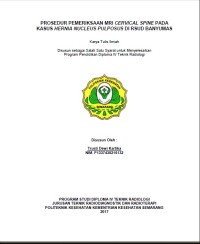
Skripsi D IV
PROSEDUR PEMERIKSAAN MRI CERVICAL SPINE PADA KASUS HERNIA NUCLEUS PULPOSUS DI RSUD BANYUMAS
XML
MRI examination is an examination that support process of degenerative of discus intervertebralis, identify compression of medulla spinalis and radiks nerve. To product an optimum image, we need to choose coil and positioning precisely. MRI cervical spine in HNP case was doing with neutral position by using mri spine coil. One of disadvantages neutral position, there is patient motion that impact the image. The purpose of this is knowing MRI cervical spine MRI cervical spine examination procedures, knowing the motive not using gradient echo pulse sequence in MRI cervical spine examination procedure and knowing the motive of using MRI spine coil with element anterior in MRI cervical spine examination procedure in HNP cases at Banyumas hospital.
The type of this research is qualitative with case study approached. In this research, the researcher take 3 patients with HNP case. The subjects of this research are 3 radiographers, 2 radiology doctors and 1 sender doctor. Data was collected by doing direct observation, indepth interview with respondent, and documentation. Analysis process was done by using interactive models.
The result shows that MRI cervical spine procedure in HNP case in Banyumas hospital was done by supine position head first. Neutral position of cervical spine by using MRI spine coil. Keep this position at center of coil. Laser beam is adjusted at level cartilage cricoids. Then, the researcher taking the routine sequences consists of T1WI SE axial and sagital, T2WI FSE axial, sagital and coronal, STIR sagital and 3D Myelografi.That routine sequences are enough for detecting HNP, gradient echo sequences are not applicable for the routine MRI cervical spine procedure because of the longer time and the results which is needed for HNP refers to an inflamation. Image information with neutral position, at T1WI SE sequence can show anatomical image consists of cervical spine 1 until 7, corpus vertebrae, discus vertebrae, ligament, nucleus pulposus canalis spinalis and foramen neuralis. At T2WI FSE can show pathology image, STIR can show oedema in bone marrow and 3D Myelography can show buldging of discus. Then, with extension position of cervical spine, if there is HNP, there is a process of thickening ligamentum flavum that results a buldging.
Informasi Detail
| Pernyataan Tanggungjawab |
Yeti Kartikasari,S.T,M.Kes > Siti Daryati, S.Si, M.Sc
|
|---|---|
| Pengarang |
TRUSTI DEWI KARTIKA - Pengarang Utama
|
| NIM |
P1337430216132
|
| Bahasa |
English
|
| Deskripsi Fisik |
XV ; 98 hal ; 28 CM
|
| Dilihat sebanyak |
1688
|
| Penerbit | Poltekkes Kemenkes Semarang : Polekkes Kemekes Semarang., 2017 |
|---|---|
| Edisi | |
| Subjek | |
| Klasifikasi |
NONE
|







